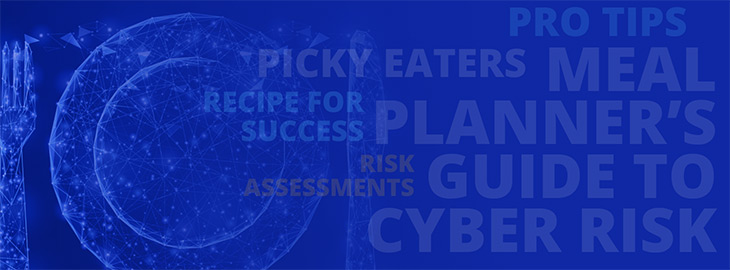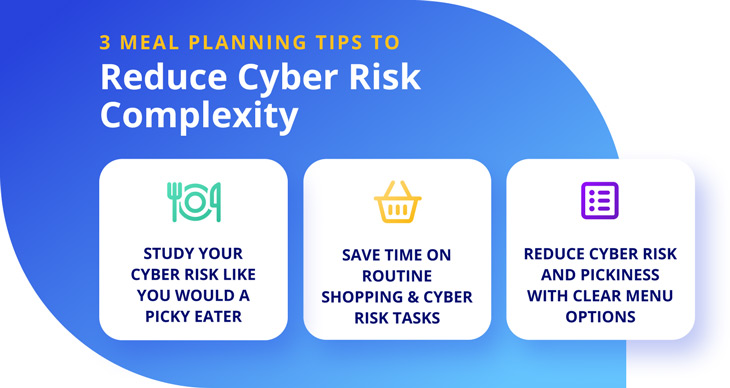
Technological innovations have unlocked a world of possibilities in the 21st century, and now, many common and tedious tasks can be quickly done online. Whether you’re collaborating on business processes, renewing your license or ordering groceries – the internet provides a streamlined avenue for consumers and organizations.
An interesting side-effect is the reduced tolerance for manual, complicated or inefficient processes. Sadly, one of those tedious processes is conducting risk assessments.
Meal Planning Tips to Reduce Cyber Risk Complexity
In partnership with Researchscape, RiskOptics surveyed 261 cyber risk and IT professionals to understand current challenges companies are facing involving cybersecurity and IT risk, as well as steps organizations are taking to combat this risk. Based on the results, most respondents found performing risk assessments harder than renewing their driver’s licenses in person.
But I equate it to weekly meal planning for a large family! And just as I simplified meal planning for my family of seven, you can reduce the complexity and challenges of cyber risk with my pro tips below.

#1. Study Your Cyber Risk Like You Would a Picky Eater
The growing and dynamic nature of risk makes it difficult for organizations to keep up with the evolving tactics employed by hackers. Further, the complexity of technology and the interconnectedness of systems create an intricate web of potential vulnerabilities.
However, Gartner asserts that the real problem for companies is not that they face more risk – it’s that they don’t know what risks they are taking, how much risk they are taking on or whether they are taking the right risks. In fact, 86% percent of enterprise risk management leaders say their decisions always or sometimes lead to risk events that could have been avoided. 1
Threats and threat actors are like “picky eaters.” A picky eater has strong preferences or aversions to foods and may change their preferences over time. The degree and severity of their preferences may also change over time, making it difficult to plan meals.
Context Is Key to Managing Either
To combat the picky eater, it’s essential to understand their aversions, research what alternatives are out there and identify the true impact on the meal. Is swapping peas for corn going to ruin the meal? Or is it better to leave the peas out altogether? The key to remember here is the context: what impact do the peas have on the meal or the diners? Perhaps this meal is of lower importance and the removal of a vegetable is an acceptable concession.
The same is true with risk! Seeing risk in the context of your business enables you to identify acceptable levels aligned with your business activities and prioritize remediation practices accordingly.
So, instead of focusing on all the risks that can impact your business or all of the picky eater’s preferences (which can be pretty overwhelming), start with what you know best: your business, what it wants to achieve and what it needs to protect.
Inadequate visibility – whether into the picky eater’s aversions or your risk landscape –
can sink your best efforts to manage either.
#2. Save Time on Routine Shopping & Cyber Risk Tasks
Our survey respondents also identified staffing shortages and limited resources as significant challenges. An overwhelming 80% of respondents strongly or somewhat agree that their cyber/IT risk teams are under-resourced. An equally substantial 79% acknowledge significant turnover within their teams. The pressure on these teams is further exacerbated, with 87% of respondents agreeing that it is increasing.
This aligns with another industry survey by ISC2, where 48% of respondents said they don’t have sufficient time to conduct proper risk assessments.
The lack of time and resources not only hampers the effectiveness of risk management but also exposes organizations to potential vulnerabilities and threats.
Streamline Your Processes with Automation
To address this, automation can play a vital role in streamlining processes, augmenting human capabilities and reducing the burden on cybersecurity teams. Automating routine tasks, such as evidence collection and assessment, allows teams to focus on higher-value activities, such as risk analysis and strategic planning.
The same is true with grocery shopping!
I can use an app on my phone to search for recipes, find the ingredients and even have them delivered to my door. I’m also able to search for sale items, use coupons and compare prices because all of the information is in one centralized location. In some cases, I can even set up recurring orders to have common ingredients routinely delivered to my home. All of these features are designed to save the consumer time and money.
The RiskOptics ROAR Platform
Similarly, you can use the RiskOptics ROAR Platform to automatically collect (and in some cases assess) evidence and retain it for reuse in a centralized repository. Beyond that, ROAR automatically updates your risk scores based on control performance and vulnerability management.
With this level of automation and oversight, companies ensure they stay compliant with their required frameworks while simultaneously reducing the organization’s risk.
#3. Reduce Cyber Risk and Pickiness with Clear Menu Options
To manage cyber risk successfully, effective communication is crucial. It’s essential to frame risk assessments and findings within the context of the organization’s business priorities. Aligning risk discussions with strategic objectives helps decision-makers understand the impact and make informed choices.
Equally important is the ability to communicate risk in a clear, concise and visually appealing manner. Visualizations, such as risk-over-time charts and dashboards, can provide a quick overview of the risk landscape and aid decision-making. With this, tailoring the message to the audience ensures relevance and engagement.
And lastly, encourage a culture of risk awareness and accountability across the organization. Regular training and security awareness programs can help employees understand their role in managing cyber risk and promote a proactive security mindset.
The same is true when presenting meal options. Using a menu or visual board outlining the meals for the week ensures everyone is aware of the options available. Engaging the diners in the planning or cooking processes will also help reduce pickiness and make mealtime more pleasant.
Get the Recipe for Cyber Risk Success
As cyber risk continues to change, organizations must evolve their risk management strategies too. By improving visibility, embracing automation and adopting effective communication strategies, organizations can enhance their cyber resilience. The collective effort to manage cyber risk is not only crucial for individual organizations but also for the well-being of society as a whole.
Gain deeper insight into how your peers are navigating today’s cyber risk challenges during this expert walkthrough of RiskOptics and Researchscape’s recent industry survey. In just 58 minutes, you’ll see where the bar for success is and how to leap over it with our proven recipe for success.
Sources
1 Gartner, The “Risk Balance Sheet” – What It Is and Why You Need One, Matthew Shinkman, 4 May 2023




